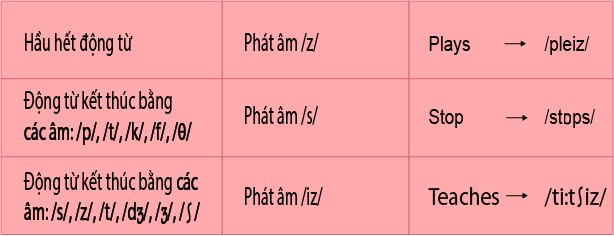How to add s, es after nouns and verbs
Even though you have been studying English for a long time, surely many of you still feel confused when expressing the plural form of nouns, specifically adding s and es when speaking and writing. So which nouns need to add s or es for the plural and how to read them correctly? Join EnglishTopVN to learn in detail how to add s es to nouns in the following article!
1. When to add "s" and "es" to verbs and nouns
In the simple present tense with regular verbs, we must add "s" or "es" after the verb in the third person singular.
- In singular nouns, we add "s" or "es" to turn it into a plural noun.
- The question is when to add "s" and when to add "es"?

- Verbs and nouns ending in O, S, X, Z, CH, SH add ES
In this case we have the following examples:
-
Box => Boxes
-
Wash => Washes
-
Go => Goes
-
Tomato => Tomatoes
If the word ch pronunciation is /k/ then we just need to add "S" never mind.
-
stomach → stomachs
- For verbs and nouns that end in Y, we change Y to I and then add ES
This case is very rare, the following are common words.
-
Fly => Flies
-
Sky => Skies
- In the remaining cases, we add S
This is the last case, we will add S after verbs and nouns that do not fall into the above two cases.
-
Eat => Eats
-
Care => Cares
-
Apple => Apples
-
Laptop => Laptops
-
Drive => Drives
You need to pay attention when dividing verb In the present simple tense we have to add "s" or 'es" for affirmative form, so we need to consider the last characters of the word to choose one of the two.
For noun When changing to plural, we do not always add "s" or "es", but have another word to replace it. We call these irregular nouns.
For example:
|
Singular |
Many |
|
woman |
women |
|
man |
men |
|
child |
children |
|
tooth |
teeth |
|
foot |
feet |
|
person |
people |
|
leaf |
leaves |
Or there are some nouns that are the same in both singular and plural, you just keep the name.
|
Singular |
Many |
|
sheep |
sheep |
|
fish |
fish |
|
deer |
deer |
|
species |
species |
|
aircraft |
aircraft |
2. Pronunciation when adding "s", "es" to verbs and nouns
The following image shows the correct pronunciation for verbs, similar to nouns.

- Pronounced as /from/ when words end in wind consonants/s/, /z/, /ʃ/, /ʒ/, /tʃ/, /dʒ/(vocabulary words ending in the letters s, ss, ch, sh, x, z, o, ge, ce).
-
Classes – /klɑ:siz/
-
Washes – /wɒ∫iz/
-
Misses - / misiz/
-
Causes - /kɔ:ziz/
- Except for the wind sounds mentioned above, we pronounce it as /s/ when words end in voiceless consonants that DO NOT vibrate (also called tone deaf): /o/, /k/, /p/, /f/, /t/ (fromThe ending vocabulary is: th, k, p, f, t).
-
Books – /bʊks/
-
Lamps – /læmps/
-
Laughes – /lɑ:fs/
-
Breathes – / bri:ðs/
- Pronounced as /z/ when the word ends with the remaining sounds: voiced WITH VIBRATION.
-
Plays – /pleiz/
-
Bags – /bægz/
-
Speeds – /spi:dz/
⇒ So we have three main pronunciations, the first is /from/, Monday is /s/ and the third is /z/.

